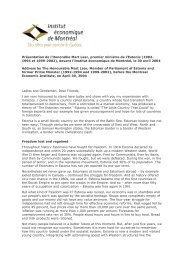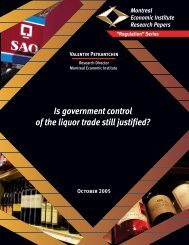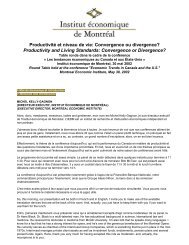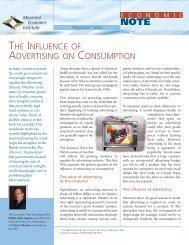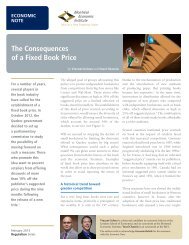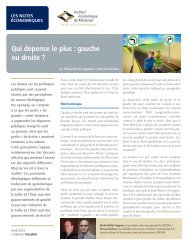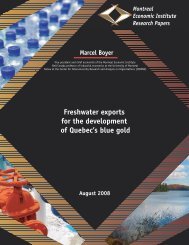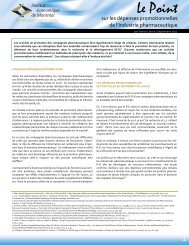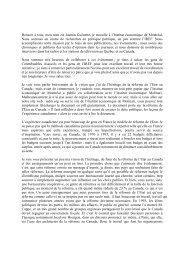Union certification: Developing a level playing field ... - LabourWatch
Union certification: Developing a level playing field ... - LabourWatch
Union certification: Developing a level playing field ... - LabourWatch
Create successful ePaper yourself
Turn your PDF publications into a flip-book with our unique Google optimized e-Paper software.
<strong>Union</strong> <strong>certification</strong>: <strong>Developing</strong> a <strong>level</strong> <strong>playing</strong> <strong>field</strong> for labour relations in Quebec4. AnalyticalReview of LabourRepresentation:<strong>Union</strong> versusNon-union Alternatives<strong>Union</strong>ization is not the only model thatallows workers to be represented in the context oflabour relations. According to Harcourt andLam, 1 union <strong>certification</strong> serves only a smallportion of workers. By dividing employees intoseven theoretical groups, the authors show thatonly two of these seven groups have theirinterests served by <strong>certification</strong>. Even for workerswho could be potentially served by union<strong>certification</strong>, the rigid system of <strong>certification</strong> willnot easily let them change their representative, forexample. In their view: “Certification is akin to apolitical election in which the electorate ispermitted to vote only once, as if people’spreferences are forever set in stone. […] Certificationmakes unionism a take-it-or-leave-itchoicefor the entire bargaining unit, with littleregard for the increasingly diverse workforce,their divergent interests, and their diversepreferences for different kinds of representation.”2 The authors therefore believe that<strong>certification</strong> systems have fundamental flaws;they not only neglect individual and minorityrights in favour of collective rights, they alsorarely fulfil the needs of the majority.In their paper, the authors propose a nonunionform of representation that actuallyemphasizes employee representation rather thanjust unionism. Under compulsory proportionalrepresentation, workers would have the freedomto vote for any representative, and this would notbe restricted to unions (in other words, it wouldinclude non-union representation). Proportionalrepresentation bases the share or proportion ofrepresentatives on the percentage of votersupport. This approach would allow for minorityvoter representation and reduce free riding.Non-union employee representation (NER)can be defined as “one or more employees whoact in an agency function for other employees indealings with management over issues of mutualconcern, including the terms and conditionsunder which people work. Selected workers’representatives meet with managers, usually incommittee-type structures in which communicationand exchange of thoughts is fostered.Representatives usually are internal to thecompany and serve leadership roles for limitedterms.” 3Kaufman and Taras note that, even thoughunions have been on the decline in the NorthAmerican private sector, this has not necessarilylead to a “representation gap”: alternative formsof employee representation are on the rise incorporate environments. Indeed, they believe thatnon-union forms of employee representationhave recently emerged as a contentious issue inboth academic and policy-making circles. Theyhave identified four trends that seem to explainthis phenomenon.1. Mark Harcourt and Helen Lam, “<strong>Union</strong> <strong>certification</strong>: A criticalanalysis and proposed alternative,” WorkingUSA: The Journal of Laborand Society, Vol. 10, No. 3 (August 2007), pp. 327-345.2. Id., p. 329.3. Daphne Taras and Bruce Kaufman, “Nonunion EmployeeRepresentation in North America: Diversity, Controversy andUncertain Future,” Industrial Relations Journal, Vol. 37, No. 5 (August2006), pp. 513-542, on page 515.Montreal Economic Institute23



